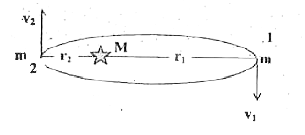A planet of mass moves along an ellipse around the sun so that its maximum and minimum distance from the sun are equal to and respectively. Find the angular momentum of this planet relative to the centre of the sun. mass of the sun is .
The angular momentum
………
Conservation of angular momenta at point and ,
………..
Conservation of energy at and
..........
Using equation and we obtain

Topper's Solved these Questions
- GRAVITATIONBOOK - FIITJEECHAPTER - GRAVITATIONEXERCISE - Solved problem (Objective)
15 Videos
- GRAVITATIONBOOK - FIITJEECHAPTER - GRAVITATIONEXERCISE - Comprehension
13 Videos
- GRAVITATIONBOOK - FIITJEECHAPTER - GRAVITATIONEXERCISE - Numerical based Question
2 Videos
- GMP ASSESMENTBOOK - FIITJEECHAPTER - GMP ASSESMENTEXERCISE - Numerical Based
61 Videos
- HEAT AND TEMPERATUREBOOK - FIITJEECHAPTER - HEAT AND TEMPERATUREEXERCISE - NUMERICAL BASES QUESTIONS
1 Videos
Similar Questions
A planet of mass m moves along an ellipse around the Sun so that its maximum and minimum distances from the Sun are equal to r1 and r2 respectively. Find the angular momentum M of this planet relative to the centre of the Sun.
View SolutionA planet of mass m revolves in elliptical orbit around the sun of mass M so that its maximum and minimum distance from the sun equal to ra and rp respectively. Find the angular momentum of this planet relative to the sun.
View Solution
Knowledge Check
A comet of mass m moves in a highly elliptical orbit around the sun of mass M the maximum and minium distacne of the comet from the centre of the sun are r1 and r2 respectively the magnitude of angular momentum of the comet with respect to the centre of sun is
A[GM1r1+r2]1/2B[GMmr1r1+r2]1/2C[rGM2r1r2r1+r2]1/2D[2GMm2r1r2r1+r2]1/2A planet of mass m is moving in an elliptical orbit about the sun (mass of sun = M). The maximum and minimum distances of the planet from the sun are r1 and r2 respectively. The period of revolution of the planet wil be proportional to :
Ar3/21Br3/22C(r1−r2)3/2D(r1+r2)3/2A planet of small mass m moves around the sun of mass M along an elliptrical orbit such that its minimum and maximum distance from sun are r and R respectively. Its period of revolution will be:
A2π√(r+R)36GMB2π√(r+R)33GMCπ√(r+R)32GMD2π√(r+R)3GM
A planet of mass moves alng an ellipes around the sun so that its maximum distance from the sum are equal to r1 and r2 respectively . Find the angular momenture L of this planet relative to the centre of the sun.
[Hint :L Rember that at the maximum and minimum distance velocity is perpendicular to tthe position vectors of the planet . Apply the princples of conservation of angula r momenture and energy .]
View SolutionA planet of mass m moves along an ellipse around the sum of mass M so that its maximum and minimum distances from sum are a and b respectively. Prove that the angular momentum L of this planet relative to the centre of the sun is L=m√2GGMab(a+b)
View SolutionA particle of mass m having negative charge q moves along an ellipse around a fixed positive charge Q so that its maximum and minimum distances from fixed charge are equal to r1 and r2 respectively. Calculate angular momentum L of this particle:
View SolutionA planet of mass m moves around the Sun of mass Min an elliptical orbit. The maximum and minimum distance of the planet from the Sun are r1 and r2, respectively. Find the relation between the time period of the planet in terms of r1 and r2.
View SolutionA planet of mass M moves around the sun along an ellipse so that its minimum distance from the sun is equal to r and the maximum distance to R. Making use of K epler's law, find the its period of revolution around the sun.
View Solution
